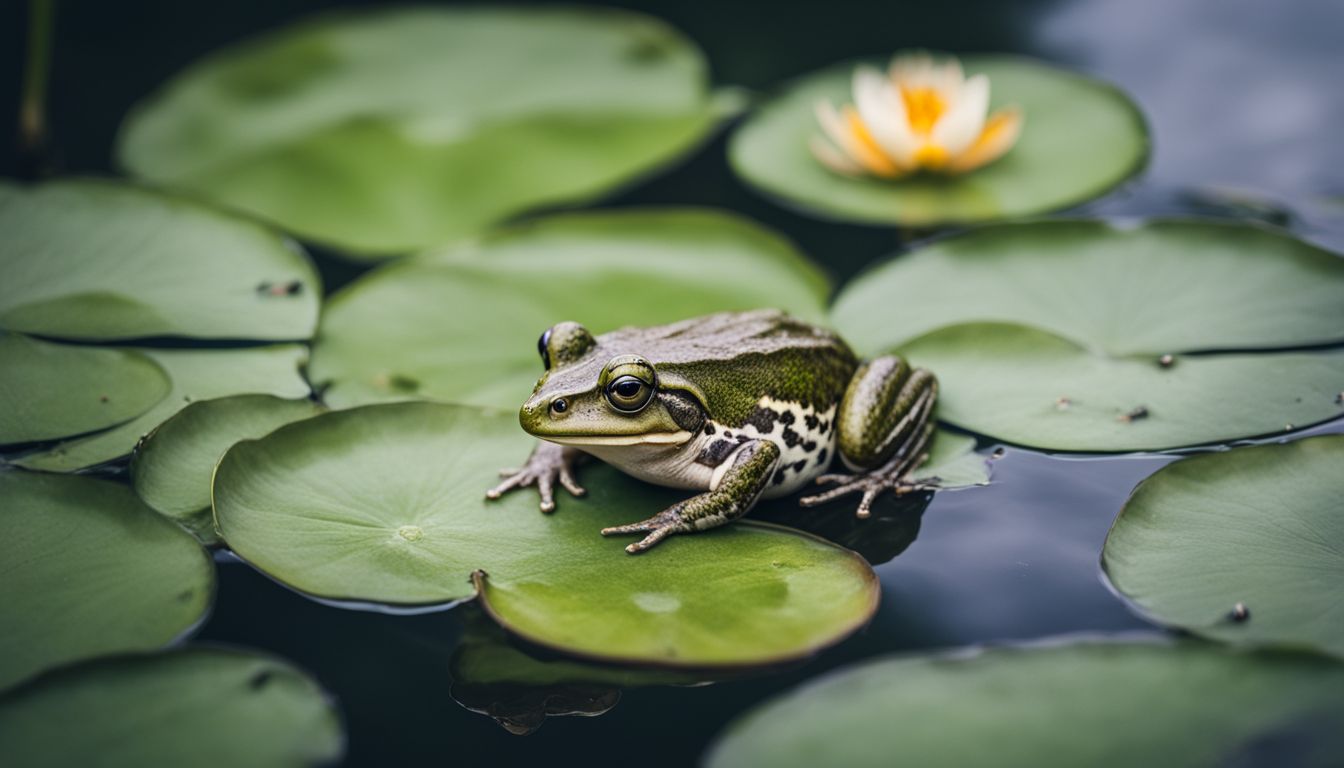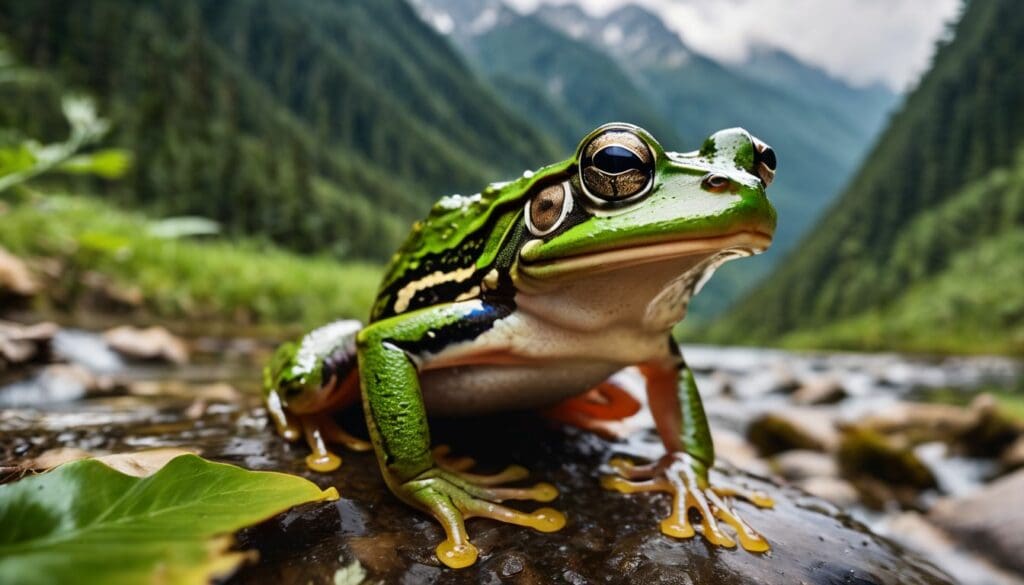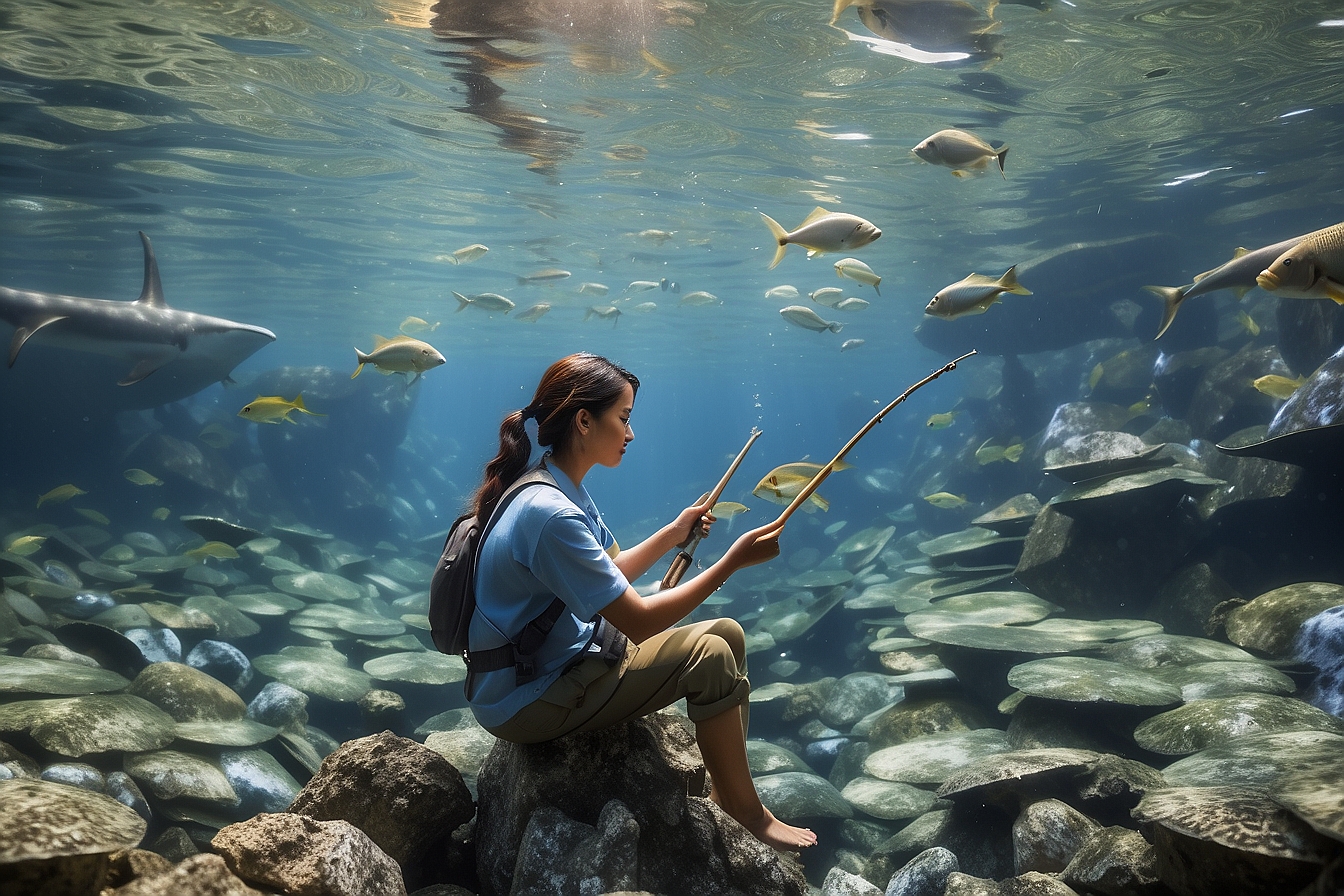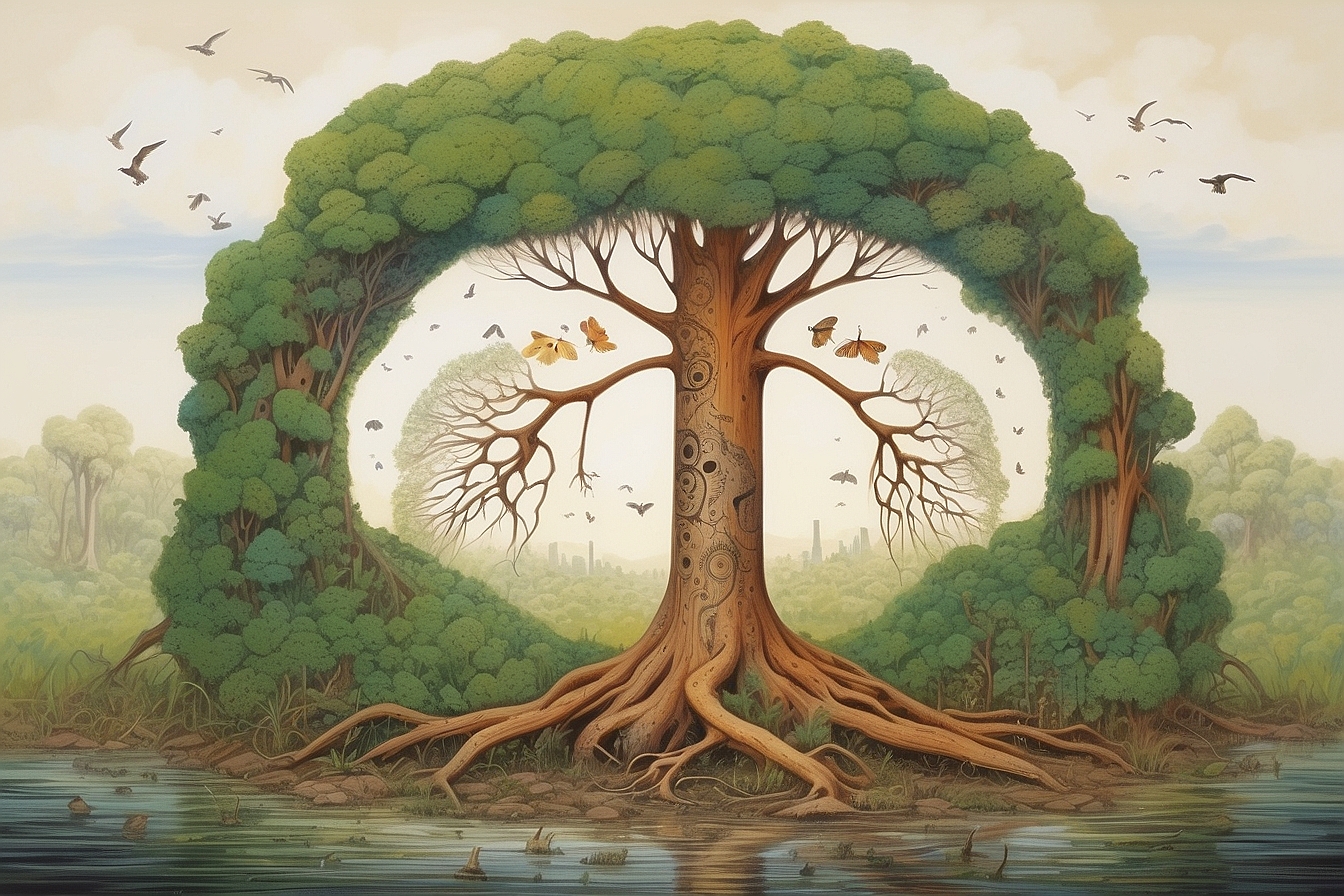As we amble through the dappled light of our local ponds and woodlands, the once vibrant medley of frog calls seems to be dwindling into silence. Just like you, we’re profoundly moved by this noticeable change; it’s disconcerting to realise that more than 40% of amphibian species are teetering on the brink of extinction.
Our latest blog post delves into the myriad factors contributing to this distressing decline and unveils essential actions that could help reverse their fortunes. Do read on and discover how we can all make a leap towards safeguarding these indispensable creatures for future generations to cherish.
Key Takeaways
- Amphibians around the world, including frogs, are in crisis with nearly one-third facing extinction due to habitat destruction, pollution, climate change, disease and over-exploitation.
- The chytrid fungus Batrachochytrium dendrobatidis (Bd) has been a major cause of decline for many amphibian species, attacking their skin and disrupting essential functions like water absorption.
- Habitat loss from deforestation and urban expansion is erasing critical breeding and feeding grounds necessary for amphibian survival.
- Amphibians play key roles in ecosystems as pest controllers and through nutrient cycling; their disappearance hints at broader environmental issues that could impact human health and economies.
- Conservation efforts such as global strategies for habitat restoration and captive breeding programs are underway to reverse amphibian population declines.
The Global Decline of Amphibians

Amphibians around the world are facing an unprecedented crisis, with populations dwindling at an alarming rate. This decline represents a significant threat to global biodiversity, and it’s essential we delve into the causes and consequences of this worrying trend.
Current state of amphibians
Today, many amphibians face a tough road ahead. Experts warn us of the alarming decline in populations around the globe. Scarily enough, nearly one-third of amphibian species are threatened with extinction, and some have already vanished before our very eyes.
Climate change wreaks havoc on fragile ecosystems where these creatures thrive, leading to irreversible damage.
Habitat destruction remains one of the biggest threats they encounter due to deforestation and pollution. Diseases like chytridiomycosis further push them towards a biodiversity crisis that not only affects amphibians but also disturbs entire food chains and ecological balances.
We see critical conservation efforts unfolding in response; however, without swift action across all sectors, we risk losing these vital species forever.
Major threats facing amphibians
As lovers of nature, we recognise the plight facing amphibians across the globe. Their decline serves as a warning bell for the health of our ecosystems. Here are some of the foremost threats these valuable creatures face:
- Habitat Loss: Expanding urban areas, agriculture and deforestation destroy the natural homes of many amphibian species. They rely on specific conditions in wetlands and forests to survive, breed and feed.
- Pollution: Chemical runoff from farms, industries, and households poisons waterways where amphibians live. Toxins can alter their reproductive abilities and overall health.
- Climate Change: Shifts in climate patterns result in droughts, flooding and temperature changes that disrupt amphibian life cycles. Breeding patterns often fall out of sync with these changes.
- Disease: Amphibians contend with fatal diseases like chytrid fungus (Batrachochytrium dendrobatidis, Bd). This illness has decimated populations worldwide, pushing some species towards apparent extinction.
- Invasive Species: Non-native plants and predators unsettle local ecosystems. Amphibians have to compete with alien species for food and habitat which they are often ill-equipped to do.
- Over-exploitation: Illegal pet trade and over-harvesting for food or medicine deplete already vulnerable populations. Rare species become even rarer due to human greed.
Understanding the Decline in Frog Populations

In exploring the decline of frog populations, we’re delving into a complex web where climate change, habitat destruction, and disease intertwine. It’s critical to unravel these threads to protect our amphibian friends from slipping away unnoticed.
Impact of climate change
Climate change wreaks havoc on the delicate balance of ecosystems, pushing amphibians to the brink. Rising temperatures and erratic weather patterns alter their breeding cycles and reduce available freshwater habitats.
Frogs and other amphibians depend on wetlands, which are shrinking as droughts become more common. As we witness these habitats vanish, amphibian populations struggle to adapt and survive in a swiftly changing world.
We see the ripple effect as climate change affects available food sources for these creatures. Increased carbon dioxide levels lead to acidified environments that can be deadly for sensitive species.
Amphibian declines due to climate change alarm us because they signal larger environmental crises at play. These changes challenge our ability to protect biodiversity and maintain healthy ecosystems crucial for all life, including humans.
Habitat loss
We witness, with growing concern, how habitat loss severely threatens amphibians around the world. Our frogs and toads depend on specific environments like wetlands and forests to survive.
But these essential spaces are shrinking fast due to human activities such as deforestation, agriculture expansion, and infrastructure development. As we convert these lands for our use, we erase not just their homes but also the microhabitats vital for their breeding and feeding.
Our impact is undeniable; many species face extinction risks because they simply have nowhere left to go. The disappearance of protected areas where they once thrived is a striking blow against biodiversity.
It undermines the role of amphibians in ecosystems, which are crucial for maintaining ecological balance. We need urgent habitat protection measures if we hope to halt this part of the global amphibian decline crisis.
Without swift action from us all, our planet may experience an irreversible loss that will echo across food chains and communities worldwide.
Disease and parasites
Diseases and parasites are wreaking havoc on frog populations worldwide. The chytrid fungus, Batrachochytrium dendrobatidis (Bd), stands out as a notorious killer, devastasting numerous species with its deadly infection.
It attacks their skin, which is essential for amphibians to breathe and regulate water intake.
Invasive parasites like the chytrid fungus thrive in damp environments that frogs call home, making it challenging to control spread. Emerging infectious diseases add another layer of stress to these creatures already struggling with habitat loss and climate change effects.
Our focus now shifts to understanding the role of fungi in the decline of amphibians, including threats beyond Bd.
Role of Fungus in the Decline of Amphibians
In the fight to understand the sharp decline of amphibian populations, we cannot overlook the devastating role fungi play, with Batrachochytrium dendrobatidis (Bd) leading this assault.
This pathogen has emerged as a silent but lethal force, rapidly pushing numerous species towards extinction by disrupting their delicate ecosystems.
Batrachochytrium dendrobatidis (Bd) and its impact
We face a hidden but deadly threat to amphibian populations worldwide, known as Batrachochytrium dendrobatidis, or Bd for short. This fungal pathogen attacks the skin of frogs, salamanders, and other amphibians.
Its deadly assault interferes with their ability to absorb water and essential electrolytes through their delicate skin, which is vital for their survival.
This silent killer has sparked declines in amphibian species around the globe. Frogs are particularly susceptible; Bd can lead to a condition called chytridiomycosis, which is often fatal if left untreated.
As we step up our conservation efforts, understanding and addressing the impact of this fungus is critical in halting the rapid loss of biodiversity within these ecologically important species.
They are not just fascinating creatures but also crucial indicators of environmental health; their decline signals deeper problems within ecosystems that ultimately affect us all.
Other fungal threats
Beyond the notorious Bd fungus, amphibians face risks from other fungal pathogens that threaten their survival. One such formidable enemy is Bsal or Batrachochytrium salamandrivorans.
This pathogen wreaks havoc on salamanders and newts especially, eating away at their skin until they can no longer survive. It comes as a double blow to populations already dwindling due to habitat loss and climate change.
Our actions play a critical role in mitigating these threats; strict biosecurity measures can help prevent the spread of devastating fungi through trade and global movement. As we strive to preserve our rich biodiversity, it is essential that we continue raising awareness about these lesser-known fungal foes while also considering what this means for Case Studies of Amphibian Declines next in our discussion.
Case Studies of Amphibian Declines
Delving into the heart-wrenching stories of our slippery friends, we explore case studies that reveal the stark reality of amphibian declines. Witness firsthand how species like the iconic Harlequin toad have been pushed to the brink, painting a vivid picture of this unfolding ecological crisis.
Harlequin toad case study
We turn our attention to the harlequin toads, which paint a vivid picture of the crisis amphibians face. These toads were once abundant in the tropical Andes, flaunting their colourful patterns as they thrived in their natural habitat.
Today, many species within this group are classified as critically endangered by the International Union for Conservation of Nature (IUCN). The villain in their story is often chytrid fungus, a deadly pathogen that has pushed some species towards extinction and forced others into steep decline.
Our challenge lies not only in combating this fungal threat but also in tackling broader issues like habitat degradation. Harlequin toads have lost vast swathes of their environment due to deforestation and pollution.
Efforts are ramping up globally with conservation actions aiming to curb these losses and create safe havens for these remarkable creatures. By preserving habitats and monitoring disease spread, we strive to pull harlequin toads back from the brink and ensure their vibrant presence continues in our world’s biodiversity mosaic.
Poison frog Phyllobates vittatus case study
In the lush forests where Phyllobates vittatus once thrived, silence tells a story of concern. These poison frogs are indicators of environmental health, and their decline signals trouble in paradise.
They have landed on the IUCN Red List as they battle against habitat loss and disease, key drivers that push them towards extinction. Our research shows these small vertebrates face threats from multiple angles – deforestation strips away their home while diseases like chytrid fungus turn their safe havens into death traps.
Conservation efforts require immediate action to halt the slide of Phyllobates vittatus down the path to possibly being extinct. We focus on preserving what remains of their natural habitats and halting further biodiversity loss within these ecosystems.
By creating conservation areas specifically designed for these amphibians’ ecological requirements, we give them a fighting chance to regrow populations and maintain biosphere integrity—a vital component for preventing a mass extinction event among our planet’s diverse wildlife.
Social Impact of Amphibian Decline
The disappearing act of our amphibians doesn’t just rob us of their intriguing presence; it unravels the delicate tapestry of ecosystems, affecting us in ways we often don’t anticipate.
From pest control to water purification, these creatures quietly underpin a host of services critical to our wellbeing and economic stability.
Role of amphibians in ecosystems
Amphibians play a crucial role in maintaining the delicate balance of ecosystems. They act as both predator and prey, fitting perfectly into the food chain. As key predators, they control populations of insects and other small creatures, which helps prevent plagues and disease spread.
Their presence keeps insect numbers at bay, ensuring crops aren’t overwhelmed by pests.
Their unique life cycle also makes them vital for nutrient cycling in aquatic and terrestrial environments. Frogs and toads spend part of their lives in water and on land, contributing to both habitats.
When they lay eggs in water bodies, they provide essential nutrients that support fish and other aquatic life.
Moreover, healthy amphibian populations are indicators of environmental quality; they’re often referred to as ‘canaries in the coal mine’. Their permeable skin absorbs toxins from their environment making them sensitive to even slight changes — when amphibians suffer or disappear, we know our natural world is out of sync.
We rely on these creatures more than we realise – not just for keeping bug populations down but also for advancing scientific research due to their regenerative abilities which offer insights into medical sciences.
Preserving them isn’t just about saving a species; it’s about safeguarding our planet’s biodiversity and securing nature-based solutions that benefit us all.
Economic implications of amphibian decline
As we witness a decrease in amphibian populations, the effects ripple through our economies. Frogs and other amphibians play a crucial role in controlling pests that attack crops, saving farmers billions in pest control each year.
With fewer amphibians to keep these pests at bay, crop yields suffer, and food prices can rise.
Moreover, the pharmaceutical industry relies on compounds derived from amphibian skin for developing life-saving medications. Losing these species could hinder medical advancements and drive up healthcare costs as valuable resources for drug discovery become scarce.
We must acknowledge that protecting amphibians is not just an environmental concern; it’s an economic necessity with far-reaching consequences for our livelihoods and well-being.
Conservation Efforts to Save Amphibians
We’re uniting globally to tackle the alarming decline in amphibians, forging conservation strategies that ignite hope for these vital creatures. From habitat restoration to captive breeding programmes, our efforts are pivotal in reversing the tide of extinction threatening their future.
Global conservation strategies
In our fight to protect amphibians, we are adopting conservation strategies that span across borders. Herpetologists and wildlife conservationists are working together globally to develop action plans that can help save these vulnerable species from the brink of extinction.
They’re using tools like the IUCN Red List to identify which species need urgent attention and setting up protected areas where these creatures can thrive without human interference.
We engage local communities in habitat protections, as they play a crucial role in maintaining biodiverse ecosystems. By educating individuals on the ground about the importance of amphibians, we foster an environment where people actively participate in conservation efforts.
Our collective actions also include captive breeding programs designed to reintroduce populations back into their natural habitats once threats have been mitigated or removed.
Successful initiatives and their impact
We’ve witnessed inspiring success stories in the fight to save our amphibians. The Global Amphibian Assessment, a massive effort to evaluate the conservation status of thousands of species, has fuelled action worldwide.
By pinpointing those at greatest risk, we’ve been able to direct resources where they’re most needed and tailor conservation strategies effectively.
Efforts such as habitat restoration projects have made significant strides in reversing population declines. Restoring wetlands provides not only breeding grounds for frogs but also strengthens ecosystems for other wildlife.
In regions hit hard by chytrid fungus outbreaks, biologists are instituting captive breeding programs which have helped bring species like the mountain yellow-legged frog back from the brink.
Each successful initiative underscores our potential to make real change when we focus on targeted conservation priorities and work collaboratively towards planetary boundaries that protect all forms of life.
Future Projections for Amphibian Populations
As we look ahead, concerning patterns suggest that amphibians may face an uncertain future, with mounting threats likely leading to further declines and extinctions. Yet there remains a glimmer of hope, hinging on our collective action and the resilience nature often displays when given a chance to recover.
Predicted declines and extinctions
Scientists warn us that many amphibian species face a grim future. We see predictions of sharp declines and numerous extinctions in the coming decades. The IUCN Red List categories list many as critically endangered or on the brink of disappearing forever.
This dire situation calls for urgent action to prevent these losses.
Our studies suggest climate change, habitat destruction, and disease are accelerating threats to amphibians worldwide. With shrinking populations, the extinction crisis looms closer.
Amphibians like the golden toad have already vanished; others could soon follow if trends continue unchecked. We must address this crisis head-on to reverse these alarming projections and safeguard our planet’s biodiversity.
Potential for recovery
Despite the daunting predictions, we see glimmers of hope for amphibians across the globe. Conservation methods are stepping up to address the amphibian extinction crisis, with efforts ranging from captive breeding programmes to habitat restoration.
We’re acting now; our swift intervention can halt population declines and even re-establish species in their natural habitats.
With each successful reintroduction and every hectare of wetland protected, we strengthen the foundation for recovery. By supporting global conservation strategies and backing local initiatives that directly impact amphibians, we contribute to turning back the tide on these threatened species.
Our combined actions can rewrite future projections, securing a place for frogs and their kin in our world’s precious ecosystems.
The Importance of Amphibians in the Ecosystem
Amphibians are vital for maintaining the delicate balance of our ecosystems, playing key roles in managing insect populations and nutrient cycling. Their presence is a marker of environmental health, acting as both predator and prey within their habitats.
Role in the food chain
We often overlook the critical part amphibians play in maintaining a balanced food web. Frogs, for example, gobble up vast amounts of insects, controlling their populations and preventing outbreaks that could be harmful to other species and agriculture.
They are essential pest controllers in many environments across the globe.
On the flip side, amphibians serve as a vital food source for a number of predators including birds, fish, and mammals. Their presence ensures these creatures have enough to eat, sustaining a diverse array of wildlife within ecosystems.
Without amphibians fulfilling their role on both ends of the food chain, we would see dramatic shifts with unpredictable consequences for biodiversity and environmental health.
Importance in maintaining habitat diversity
Amphibians play a crucial role in the web of life, and their decline sends ripples through the food chain. Diverse habitats are vital for these creatures to thrive. They need clean waters to breed, leaf-littered forests to hunt, and untouched wetlands to provide shelter from predators.
By preserving varied landscapes, we ensure frogs and their kin have the environments they need for every stage of their lifecycle.
Healthy ecosystems depend on this habitat variety to maintain balance. If one piece falls out of place, such as when a wetland dries up or a forest is cleared, the entire system feels the impact.
We must work tirelessly to protect different types of natural areas – not just for amphibians but for all species that rely on them. Each unique ecosystem also offers us invaluable environmental services like water purification and carbon sequestration – benefits we cannot afford to lose amidst pressing climate change concerns.
The Consequences of Losing Amphibians
The disappearance of amphibians from their natural habitats sends a ripple effect through the ecosystem, disturbing the delicate balance that nurtures diverse life forms. It’s not just about losing a species; it’s about unravelling the complex web of relationships that sustains us all.
Impact on biodiversity
As amphibians dwindle, we witness a ripple effect through the web of life. These creatures often hold key roles in controlling insect populations and breaking down organic materials, which means their loss can lead to unbalanced ecosystems.
With each species that edges closer to extinction, invaluable genetic diversity vanishes — this is a diversity that maintains ecosystem resilience against environmental changes and diseases.
Our planet’s health relies on the intricate connections between species and habitats. Frogs and other amphibians contribute significantly to nutrient cycling within their environments; without them, these systems may fail to operate properly.
Consider the harlequin frogs or Rabbs’ fringe-limbed tree frog – once abundant contributors to biodiversity now teetering on the brink of being lost forever due to the global amphibian extinction crisis.
Their decline poses serious risks not only for natural habitats but also for human societies relying on these biodiverse systems for clean water and pest regulation.
Impact on human health and agriculture
Moving from the loss of biodiversity, we see how our wellbeing and food supply hinge on amphibian survival. Frogs and other amphibians help control pests that spread disease and damage crops, playing a key role in maintaining human health and maximising agricultural yields.
Pesticide use rises when these natural pest controllers disappear, leading to increased chemical runoff into water sources.
Their decline also disrupts pollination processes since amphibians form part of a complex web involving many species like bees. We rely heavily on this balance for fruits, vegetables, and other plants crucial for nutrition and medicine.
It’s clear: protecting amphibians aligns with safeguarding our own future food security and wellbeing.
Possible Solutions and Actions
To stem the tide against amphibian decline, we must champion robust conservation efforts and enforce legal protections. Raising public awareness is crucial; every voice added to the chorus calling for change amplifies our chance to ensure these vital creatures endure.
Conservation efforts
We’re joining forces globally to combat the decline of amphibians. Our strategies focus on habitat restoration, legal protections and breeding programmes that aim to bolster dwindling populations.
We support international collaborations like the Amphibian Survival Alliance, which harnesses resources from various organisations dedicated to amphibian conservation.
In our communities, we push for local initiatives that facilitate the creation of conservation priority areas. These sanctuaries provide a safe haven free from threats such as pollution or invasive non-native species.
Our efforts extend to educating others about the critical role amphibians play in ecosystems and why their survival is vital for maintaining planetary boundaries. By rallying both experts and volunteers, we’re able to carry out research and monitoring that inform actions necessary for saving these important creatures before it’s too late.
Legal protections
Building on conservation efforts, we must also address the legal protections that safeguard our precious amphibians. Laws can serve as strong defenders against threats to these species.
Countries around the world enact regulations that prohibit harmful activities and promote sustainable practices. By putting these laws in place, governments help ensure that habitats are preserved and destructive behaviors are curtailed.
We see how international agreements like CITES (the Convention on International Trade in Endangered Species of Wild Fauna and Flora) play a critical role in preventing over-exploitation through global trade.
National legislation, such as the Endangered Species Act in some countries, provides a framework for recovery plans and the protection of critical habitats for species on the brink of extinction.
These legal frameworks are essential tools in maintaining population trends within safe margins and steering clear from crossing planetary boundaries toward a sixth mass extinction.
Public awareness campaigns
We need to spread the word about the plight of amphibians through dynamic public awareness campaigns. Our goal is to educate people on how their actions can directly affect these sensitive creatures and the ecosystems they inhabit.
Encouraging individuals and communities to get involved can make a substantial difference. We design our campaigns to resonate with everyone, from schoolchildren learning about frogs in science class to politicians who have the power to enact conservation laws.
Our messages highlight how protecting amphibians also safeguards our own future. We share crucial facts from the IUCN Red List of Threatened Species and showcase studies like the Global Amphibian Assessment (GAA) to illustrate just how critical the situation is.
Flyers, social media posts, community workshops – all these tools serve one purpose: rally support for amphibian conservation efforts worldwide before it’s too late.
Conclusion
As we face the global decline of frogs, our actions will shape their future. These creatures play a pivotal role in our ecosystems and losing them would disrupt nature’s balance. Efforts to save amphibians must intensify if we hope for a positive turnaround.
Let us rally behind conservation initiatives that promise a safer world for these invaluable species. Our planet’s health depends on the survival of every link in its chain, including amphibians.
FAQs
1. Why are frog populations declining around the world?
Frog populations are suffering due to habitat alteration, effects of climate change like extreme heat, and diseases such as amphibian chytrid fungus.
2. What is the IUCN Red List, and why are frogs on it?
The IUCN’s Red List categorises species based on their risk of extinction; many frog species appear on it because they face threats that could make them possibly extinct.
3. Are there any frogs that have already gone extinct?
Yes, some species like Rabbs’ fringe-limbed treefrog may be extinct because they haven’t been seen for years and fall into the data deficient category or possibly extinct according to the Amphibian Specialist Group (ASG).
4. How does climate change affect frogs’ survival?
Climate change shifts distributional boundaries and can create extreme weather conditions which lead to amphibian population declines by changing their habitats and enabling disease spread.
5. Can anything be done to help save frogs from decline?
Efforts can be made by following conservation plans laid out by organisations such as AArk, monitoring amphibian population trends through indices like the Red List Index, and reducing anthropogenic impacts that contribute to habitat destruction and global warming.





